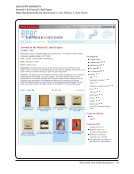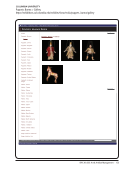14 · Survey Results: Executive Summary
choices 48 use finding aids (76%) and 35 use MARC
records (56%). Archival management tools were used
at slightly higher rates for artifacts, with 40% of re-
spondents, compared to 33% usage for art objects.
Like works of art, institutions are likely to be creat-
ing both collection and item level descriptions within
these tools. Overall, 90% of the 60 respondents pro-
vide collection-level description, and 93% provide
item-level description. Although there is a slightly
higher prevalence of item-level description of artifacts
than was the case with art, libraries are also describ-
ing artifacts at both collection and item levels.
Institutions are using many different tools to man-
age artifacts. Ten of the 60 respondents (16%) use only
one tool. Of these, three institutions each use finding
aids or a local database. One respondent uses seven
tools 11 institutions (18%) use five or more tools. The
average number of tools used to manage artifacts per
institution is three, the same as with artworks.
Nature of the collection, staffing and resources
available for description, and material type were each
cited by over 60% of respondents as factors in de-
termining which to use in a particular case. Several
comments pointed to limitations of systems as an un-
derlying factor. One respondent said, “Some artifacts
have large amounts of detailed information … for
which there is no room to efficiently input or display.
Also need a system that allows managing and easy
link to related … materials.”
Similarly, information about artifact collections
is made available to the public in a variety of ways.
Thirty-eight respondents (60%) indicated that the li-
brary catalog is the primary mechanism for the public
to find records for artifacts 33 (52%) distribute docu-
ments through a website. The same percentage of
institutions offers a web-accessible database of some
kind the databases include archival management
systems, museum collection management systems,
and library-developed databases. Thirteen institu-
tions (21%) indicated that no information is available
to the public.
Factors in Choice of Tools
Looking at the aggregated data, the overall patterns for
management of art and artifact collections were quite
similar. These findings suggest that ARL members
are likely to use several tools to manage art and arti-
fact collections, and that the ILS and finding aids are
the most prevalent tools for both types of materials.
Respondents also seem likely to describe materials at
collection and item levels in all types of tools.
Looking at some subsets of the survey responses,
some other notable patterns emerged. An identical
number and percentage of institutions use a museum
collection management system for artwork and for
artifacts: 11 institutions or 18%. Nine use it for both
types of material.
Another factor is the type of collection the institu-
tion considered their primary collection. Twenty-six
respondents considered books/published material
to be the primary collection 28 indicated archives 13
manuscripts. Looking at the art and artifact manage-
ment tools broken down by primary collection did
reveal some differences although MARC records and
finding aids were the most used tool, the distribution
took on different characteristics.
Collections that considered books to be their pri-
mary collection used MARC records for art collec-
tions at a high rate, but used finding aids for artifact
collections. Archival institutions were highly likely to
use finding aids for both art and artifacts. Manuscript
institutions used MARC records at about the same
rate as book institutions and finding aids at about the
same level as archival institutions. These findings are
not surprising and are likely due to the descriptive
and collecting practices of these types of collections,
but it is interesting to see that there is a logical correla-
tion with primary collection types.
Books Archives MSS
MARC Records: Art 65% 42% 69%
Finding Aids: Art 61% 83% 92%
MARC Records: Artifacts 57% 44% 58%
Finding Aids: Artifacts 70% 85% 83%
Another factor correlated with tool selection is col-
lection size. While in all cases finding aids or MARC
records are the most used tool for descriptions, there
are some differences based on collection size.
Collections with fewer than 500 objects are far
more likely to use finding aids than any other tool
choices 48 use finding aids (76%) and 35 use MARC
records (56%). Archival management tools were used
at slightly higher rates for artifacts, with 40% of re-
spondents, compared to 33% usage for art objects.
Like works of art, institutions are likely to be creat-
ing both collection and item level descriptions within
these tools. Overall, 90% of the 60 respondents pro-
vide collection-level description, and 93% provide
item-level description. Although there is a slightly
higher prevalence of item-level description of artifacts
than was the case with art, libraries are also describ-
ing artifacts at both collection and item levels.
Institutions are using many different tools to man-
age artifacts. Ten of the 60 respondents (16%) use only
one tool. Of these, three institutions each use finding
aids or a local database. One respondent uses seven
tools 11 institutions (18%) use five or more tools. The
average number of tools used to manage artifacts per
institution is three, the same as with artworks.
Nature of the collection, staffing and resources
available for description, and material type were each
cited by over 60% of respondents as factors in de-
termining which to use in a particular case. Several
comments pointed to limitations of systems as an un-
derlying factor. One respondent said, “Some artifacts
have large amounts of detailed information … for
which there is no room to efficiently input or display.
Also need a system that allows managing and easy
link to related … materials.”
Similarly, information about artifact collections
is made available to the public in a variety of ways.
Thirty-eight respondents (60%) indicated that the li-
brary catalog is the primary mechanism for the public
to find records for artifacts 33 (52%) distribute docu-
ments through a website. The same percentage of
institutions offers a web-accessible database of some
kind the databases include archival management
systems, museum collection management systems,
and library-developed databases. Thirteen institu-
tions (21%) indicated that no information is available
to the public.
Factors in Choice of Tools
Looking at the aggregated data, the overall patterns for
management of art and artifact collections were quite
similar. These findings suggest that ARL members
are likely to use several tools to manage art and arti-
fact collections, and that the ILS and finding aids are
the most prevalent tools for both types of materials.
Respondents also seem likely to describe materials at
collection and item levels in all types of tools.
Looking at some subsets of the survey responses,
some other notable patterns emerged. An identical
number and percentage of institutions use a museum
collection management system for artwork and for
artifacts: 11 institutions or 18%. Nine use it for both
types of material.
Another factor is the type of collection the institu-
tion considered their primary collection. Twenty-six
respondents considered books/published material
to be the primary collection 28 indicated archives 13
manuscripts. Looking at the art and artifact manage-
ment tools broken down by primary collection did
reveal some differences although MARC records and
finding aids were the most used tool, the distribution
took on different characteristics.
Collections that considered books to be their pri-
mary collection used MARC records for art collec-
tions at a high rate, but used finding aids for artifact
collections. Archival institutions were highly likely to
use finding aids for both art and artifacts. Manuscript
institutions used MARC records at about the same
rate as book institutions and finding aids at about the
same level as archival institutions. These findings are
not surprising and are likely due to the descriptive
and collecting practices of these types of collections,
but it is interesting to see that there is a logical correla-
tion with primary collection types.
Books Archives MSS
MARC Records: Art 65% 42% 69%
Finding Aids: Art 61% 83% 92%
MARC Records: Artifacts 57% 44% 58%
Finding Aids: Artifacts 70% 85% 83%
Another factor correlated with tool selection is col-
lection size. While in all cases finding aids or MARC
records are the most used tool for descriptions, there
are some differences based on collection size.
Collections with fewer than 500 objects are far
more likely to use finding aids than any other tool


















































































































































































